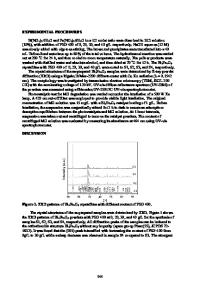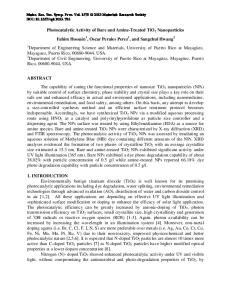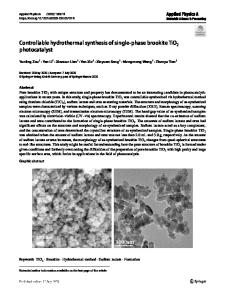Hydrothermal Synthesis of Nanorods/Nanoparticles TiO 2 for Photocatalytic Activity and Dye-sensitized Solar Cell Applica
- PDF / 2,170,957 Bytes
- 6 Pages / 612 x 792 pts (letter) Page_size
- 35 Downloads / 643 Views
0951-E09-04
Hydrothermal Synthesis of Nanorods/Nanoparticles TiO2 for Photocatalytic Activity and Dye-sensitized Solar Cell Applications Sorapong Pavasupree, Supachai Ngamsinlapasathian, Yoshikazu Suzuki, and Susumu Yoshikawa Institute of Advanced Energy, Kyoto University, Uji, Kyoto, 611-0011, Japan
ABSTRACT Nanorods/nanoparticles TiO2 with mesoporous structure were synthesized by hydrothermal method at 150 oC for 20 h. The samples characterized by XRD, SEM, TEM, SAED, HRTEM, and BET surface area. The nanorods had diameter about 10-20 nm and the lengths of 100-200 nm, the nanoparticles had diameter about 5-10 nm. The prepared material had average pore diameter about 7-12 nm. The BET surface area and pore volume of the sample are about 203 m2/g and 0.655 cm3/g, respectively. The nanorods/nanoparticles TiO2 with mesoporous structure showed higher photocatalytic activity (I3- concentration) than the nanorods TiO2, nanofibers TiO2, mesoporous TiO2, and commercial TiO2 (ST-01, P-25, JRC-01, and JRC03). The solar energy conversion efficiency (η) of the cell using nanorods/nanoparticles TiO2 with mesoporous structure was about 7.12 % with Jsc of 13.97 mA/cm2, Voc of 0.73 V and ff of 0.70; while η of the cell using P-25 reached 5.82 % with Jsc of 12.74 mA/cm2, Voc of 0.704 V and ff of 0.649. INTRODUCTION The synthesis and characterization of one-dimensional (1-D) nanostructured materials (nanotubes, nanorods, and nanowires) have received considerable attention due to their unique properties and novel applications [1-2]. Much effort has concentrated on the important metal oxides such as TiO2, SnO2, VO2, and ZnO. Amoung them, TiO2 and TiO2-derived materials are of importance for utilizing solar energy and environmental purification. TiO2 has been widely used for various applications such as a semiconductor in dye-sensitized solar cell, water treatment materials, catalysts, gas sensors, and so on [3-9]. In our previous works, nanofibers TiO2 were synthesized by hydrothermal and post heat-treatments from natural rutile sand, however, nanofibers TiO2 had rather low surface area (10-20 m2/g) [3-4]. The author’s group preliminary reported that the nanowires/nanoparticles composite structure showed better photovoltaic conversion effect in dye-sensitized solar cell [5]. In this study, nanorods/nanoparticles TiO2 with mesoporous structure (with much higher surface area, 203 m2/g) has been synthesized, which shows high photocatalytic activity and high performance in dye-sensitized solar cell. The detail microstructure, photocatalytic, and photovoltaic properties will be reported. THEORY (OR EXPERIMENT) 2.1 Synthesis
2.1.1 Nanorods/nanoparticles TiO2 with mesoporous structure Titanium (IV) butoxide (Aldrich) was mixed with the same mole of acetyacetone (ACA, Nacalai Tesque, Inc., Japan) to slowdown the hydrolysis and the condensation reactions. Subsequently, distilled water 40 ml was added in the solution, and the solution was stirred at room temperature for 5 min. After kept stirring, ammonia aqueous solution 28 % (Wako Co., Ltd.
Data Loading...











